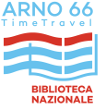ARNO66 - TIME TRAVEL
DISCOVERING 1966 FLOOD IN FLORENCE
Call 334-6606716 or email to bnc-fi.urp@beniculturali.it
Explore
the Library today and travel in the past with site-specific interactive links
to pictures and footage of November 1966. From
the entrance to the basement, from the reading room to Santa Croce cloister.
Discover the images and the stories of the Library covered by water and mud,
until the recovery of more than 1 million volumes.
THE FLOOD AND THE CITY
In the
night between November 3rd and 4th 1966, following days
of continuous rain, the waters of the Arno overflowed and submerged Florence.
For 18 hours, the city was at the mercy of a raging mix of mud and debris of
every kind, shortly joined by oil leaking from the broken boilers. The water level reached 6 meters in the
hardest hit neighbourhoods. Once the water receded, the scenes were
apocalyptic. 35 people lost their lives, of which 17 in Florence and 18 in the
nearby towns. The damage to the city’s heritage was immeasurable.
The flood caught the Italian authorities by
surprise. After an initial slip, the reaction was extraordinary. Hundreds of
people from all over Italy and the world joined Florentines, the law
enforcement authorities and the army to form the most unusual mix of volunteers
and rescue teams, mostly comprised of young people. Together have managed to
transform an acute emergency situation into a moment of collective salvation.
Soon they became known as the “mud angels”. It’s one of the first examples of
spontaneous mobilizations of young people in the 20th century.
“They ask for nothing in return – all they want is to save culture. They
shovel out mud from the museums, churches, libraries, trying to rescue
masterpieces and sacred objects […], they get covered in mud at the National Library, the State Archive,
the Vieusseux Library, the Santa Croce cloisters, the Uffizi storerooms […], mud from every
cultural institution, mud from the Synagogue, mud from San Frediano, mud from
each and every neighbourhood.”
Giorgio Batini
THE FLOOD AND THE LIBRARY
On November
4th 1966, at 06:50 AM, the Arno river overflows and breaks the first
embankment parapet: the one in front of the National Central Library. In just a
few hours the ground floor and basement are taken over by sludge. More than one
million volumes are damaged: 300.000 books, 400.000 publications such as newspapers and daily
publications, 60.000 journals, 40.000 pamphlets and miscellaneous printed
documents. Amongst the ruined books, there are ancient manuscripts notably from
the Magliabechiana and Palatina
collections, including valuable large-format ones that had been kept in the basement. The incunabula
and manuscripts kept on the first floor were able to be saved.
In the days immediately following the catastrophe,
the National Library became the centre and symbol of rescue operations
spontaneously organized by young people from all over the world. From out of
the mud and debris, books are rescued one by one and passed over from one hand
to another through human rescue chains. It is a one of a kind experience
through which experiments of drying and restoration techniques are carried out
with the help of international experts, which will lead to the creation of new
book restoration methods and the foundation of a major cutting-edge restoration
lab.
“Books were being restored even before the flood in the
National Library […], as I think they were in all Italian libraries, but there was no
particular restoration procedure. There were no general principles, but the
flood reinstated best practices and principles – principles such as the idea
that a book is a structure […], and that restoration should be carried out on the structure as a whole
and not just on a specific detail.”
Luigi Crocetti

